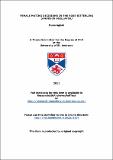Female mating decisions in the rose bitterling (Rhodeus ocellatus)
Abstract
The aim of this study was to obtain an understanding of the basis to female mating decisions in the Chinese rose bitterling (Rhodeus ocellatus). Bitterling have a resource-based mating system that involves the female laying her eggs inside the gills of a freshwater mussel. Male bitterling perform elaborate courtship behaviour and are territorial and aggressively guard mussels in their territory from other territory holders and non-territorial males. Using a series of laboratory experiments it was shown in this study that females were choosy over the males they mated with, but females were not congruent in their preferences. Female mate preferences correlated positively with offspring growth rates and survival during early development. Female mate choice did not correspond with male dominance, and there may be an intersexual conflict between female mate preferences and male dominance as a result. Females tended to prefer males with functionally dissimilar MHC alleles. MHC alleles may influence male odour cues, and females showed a preference for mussels in which the sperm of multiple males had been released, possibly indicating that females use odour cues associated with sperm release in mating decisions. Bitterling show an innate preference for the colour red in a foraging context and there may be a receiver bias for red nuptial colouration in female mating preferences. Despite a significant role for mate preferences, direct (oviposition) mating preferences were shown to be more important in the mating system. Choice of oviposition sites has both immediate (survival) consequences for offspring, as well as longer-term fitness effects.
Type
Thesis, PhD Doctor of Philosophy
Collections
Items in the St Andrews Research Repository are protected by copyright, with all rights reserved, unless otherwise indicated.

